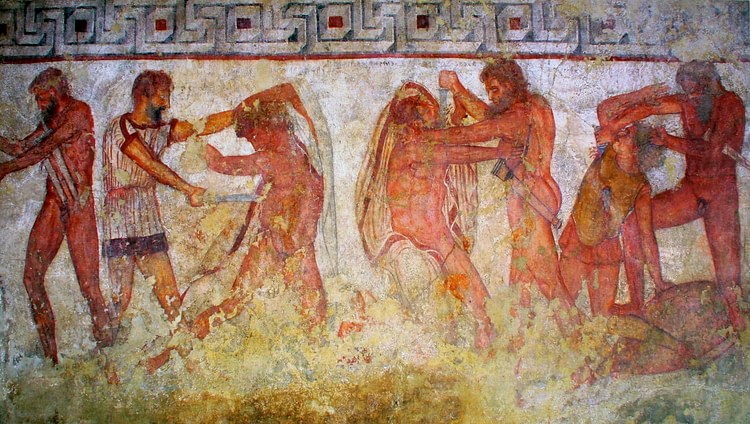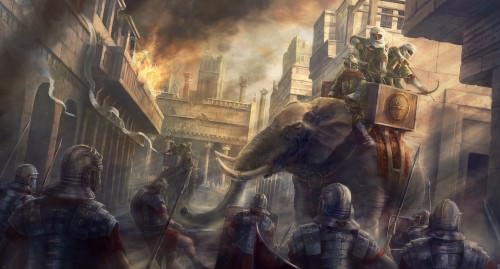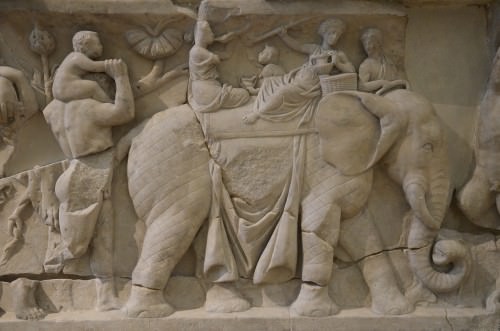Francois Tomb › Elephants in Greek & Roman Warfare » Origins and History
Articles and Definitions › Contents
- Francois Tomb › Ancient History
- Elephants in Greek & Roman Warfare › Antique Origins
Ancient civilizations › Historical places, and their characters
Francois Tomb › Ancient History
Definition and Origins

The Francois Tomb is an Etruscan tomb located at Vulci (Velch to the Etruscans ), a town located 12 km from the western coast of central Italy, by the banks of the Fiora River. Flourishing as a trading port between the 6th and 4th century BCE, Vulci's elite built many impressive tombs, and the most celebrated is the 4th-century BCE Francois Tomb. Vibrant wallpaintings on the interior walls depict scenes from mythology, a battle between Vulci and an alliance of other Etruscan citiesand the Romans in a tantalising glimpse of the still obscure relations between these two cultures, and, finally, the tomb's occupant himself.
DISCOVERY
The Francois Tomb was discovered in 1857 CE by Alessandro Francois who had been charged by Prince Torlonia, owner of vast swathes of Tuscany, to excavate the area around Vulci in search of valuable antiquities. Assisted by the historian A. Noel des Vergers, Francois would justify his reputation for lucky finds once again. He had already discovered near Chiusi the magnificent Attic black-figure vase named after him in the previous decade, and now Francois brought to light one of the most brilliantly painted and significant of all Etruscan tombs. The tomb was located in a cliff face of volcanic rock above the river Fiora, its entrance blocked by loose rubble. Dating to the mid-4th century BCE, the tomb consisted of a long passageway which led to a central atrium chamber with smaller chambers leading off it. The passageway alone took over two weeks of digging to traverse. Des Vergers describes the moment when they finally reached the tomb itself:
Everything was in the same state as on the day when the entrance was walled up. Ancient Etruria appeared before us as it was in the days of its glory. The warriors lying in full armour on their biers seemed to be resting from the battles they had fought against the Romans and Gauls. For a few minutes their shapes, clothes, stuffs, colours were visible. Then everything vanished as the outside air penetrated into the crypt, threatening to extinguish our flickering torches. It was an evocation of the past that was briefer than a dream and then faded away, as if to punish us for our reckless curiosity. (Keller, 141)
 FRANCOIS TOMB PLAN
FRANCOIS TOMB PLAN

WALL PAINTINGS
Mythological Scenes
The wall paintings of the Francois Tomb were removed by Torlonia and added to his private collection, but they are now preserved in the Villa Albani in Rome. The atrium had two main scenes, both of which are bloody massacres: an episode from Theban myth and another from Homer 's Iliad. The former shows Eteocles (King of Thebes and son of Oedipus ) and his brother Polyneikes, both nude, just at the moment of killing each other with their swords and blood consequently spurting everywhere.
The scene from the Iliad shows the sacrifice of Trojan prisoners during the funeral of Achilles ' favourite sidekick Patroclus.The Greeks are portrayed naked and killing their victims with swords. Also depicted are the figures of Charun, the gatekeeper to the underworld carrying his usual hammer (used to dislodge the heavy crossbar of the gate), and a winged Vanth, one of the Etruscan female divinities who acted as the messengers of death.

Battle Scene, Francois Tomb
An Etruscan Battle
Mixed with these mythological scenes another wall seems to be a representation of an actual battle between the Etruscans of Vulci and rivals from the other Etruscan towns of Volsinii and Sovana. To add another layer of complexity, several of the ten figures are named along with their town using the Etruscan alphabet. While some figures have Etruscan names, others have Roman ones, in reference perhaps to the 6th-century BCE conflict between the Etruscans and Romans which saw various dynastic power struggles where several of Rome's early kings were of Etruscan origin. This period of history remains obscure, and the tomb offers invaluable information, if not full answers, as to the early relations between the two cultures.
THE FRANCOIS TOMB OFFERS INVALUABLE INFORMATION, IF NOT FULL ANSWERS, AS TO THE EARLY RELATIONS BETWEEN THE ETRUSCANS & ROMANS.
The named individuals in the battle include three heroes of Vulci: Macstrna, who may be Rome's legendary second Etruscan king Servius Tullius by another name, and Caile and Avle Vipinas (two brothers) who probably were actual historical figures with tradition stating that they had settled in Rome on the Caelian Hill. Macstrna is in the act of freeing Caile Vipinas whose hands are tied, while Avle Vipinas and three others, presumably also from Vulci, attack with swords a coalition group from Volsinii, Sovana, and Rome. A Roman is identified as Cnaeus Tarquinius ( Cneve Tarchunies Rumach ), and he is cowering beneath the sword of Marce Camitlnas about to be killed. Some historians regard this Roman figure as Tarquinius Priscus, the legendary king of Rome (r. 616-579 BCE) or a younger relation. If it is the king, then the painting provides an alternative to the Roman tradition that Priscus was assassinated by his sons. The Francois Tomb would suggest that he actually lost his throne in battle with the Etruscans. This depiction of the conflict between the early Etruscan and Roman kings, created 200 years after the events, may have been due to an increasing threat of further hostilities between the two cultures at the time of the tomb's construction.

Vel Saties & Arnza, Francois Tomb
Vel Saties & the Bird
Another painting in the tomb, originally located by the doorway of the atrium, shows a man named in an inscription as Vel Saties, perhaps the occupant of the tomb. The figure, possibly a magistrate or auspicium (reader of omens), wears a dark blue embroidered cloak which has several nude male figures who are dancing while carrying shields. The man also wears a laurel crown and is accompanied by a dwarf who is named as Arnza. The dwarf is kneeling while holding a woodpecker or swallow attached to a string. The bird is about to be released, and Vel Saties looks on, perhaps, as in one interpretation, he is about to read the flight of the bird and divine its significance as an omen, a practice common in the Etruscan religion. Alternative interpretations suggest the bird is no more than a child's pet, and a third that Vel Saties gazes at the bird about to be released in a metaphor for his own imminent passage into the next life.
Elephants in Greek & Roman Warfare › Antique Origins
Ancient Civilizations
In the search for ever more impressive and lethal weapons to shock the enemy and bring total victory the armies of ancient Greece, Carthage, and even sometimes Rome turned to the elephant. Huge, exotic, and frightening the life out of an unprepared enemy they seemed the perfect weapon in an age where developments in warfare were very limited.Unfortunately, impressive though they must have seemed on the battlefield, the cost of acquiring, training, and transporting these creatures, along with their wild unpredictability in the heat of battle, meant that they were used only briefly and not particularly effectively in Mediterranean warfare.

Carthaginian War Elephant
TWO SPECIES OF ELEPHANT
In antiquity, two elephants were known – the Asian elephant ( Elephas maximus ) and the African Forest elephant ( Loxodonta cyclotis ). The latter is now almost extinct and only found in the Gambia; it was smaller than the, at the time unknown, African elephant of central and southern Africa ( Loxodonta africana ), which explains why ancient writers all claimed the Indian elephant was larger than the African. The Asian elephant became known in Europe following the conquests of Alexander the Great in the 4th century BCE and contact with the Mauryan Empire of India. So impressed was Alexander with the warelephants of Porus, who was said to have had a corps of 200 when he fought the Battle of Hydaspes in 326 BCE, that he formed his own ceremonial elephant corps. Many of Alexander's successors went one step further and employed them in battle proper. Indeed, the Seleucid Empire made sure to exclusively control the traffic in Asian elephants.
ACQUISITION & DEPLOYMENT
Elephants, being only available from Africa or Asia, were expensive commodities to acquire for Mediterranean powers. Added to this was the cost of maintaining them and training both the wild elephant and its rider to form some sort of battle order on the field of combat. Then there was the problem of transporting them to where they were needed, although famously, the Carthaginian general Hannibal managed to get at least some of his 37 elephants across the Alps and into Italy in 218 BCE.
TOSSING, RIPPING, AND CRUSHING THE ENEMY, ELEPHANTS WERE USED TO CAUSE HAVOC WITH ANY DEFENSIVE FIELDWORKS AND FORTIFICATIONS TOO.
Despite the cost and difficulties, and because in antiquity the evolution in weaponry was extremely slow, the attraction of such large animals trampling all over the enemy remained. This meant that military commanders went out of their way to supplement their armies with elephants. Seleukos I Nikator famously swapped parts of his eastern empire to gain 500 elephants from Indian emperor Chandragupta in 305 BCE. The armies of the Antigonids and Ptolemies also fielded Asian elephants, although generally in much smaller numbers. In the 370's BCE Ptolemy II trained African elephants for use in his army and even appointed a high official to be responsible for them, the elephantarchos. According to Plutarch, 475 elephants took part in the Battle of Ipsus in 301 BCE during the Successor Wars. In 275 BCE, in a battle known as the 'Elephant Victory', Antigonus Gonatas, although outnumbered, used 16 elephants to terrify an army of Gauls into retreat.
Pyrrhus of Epirus was the first commander to employ elephants in Europe when he used 20 Asian ones in his campaigns in Italy and Sicily from 280 to 275 BCE. There Pyrrhus gained notable victories against the Romans in the battles of Heraclea (280 BCE) and Asculum (279 BCE).
The Carthaginians were the next major users. Able to readily acquire African elephants from the Atlas forest region they formed an elephant corps from the 260's BCE. These were used in the First and Second Punic Wars against Rome in the mid and late 3rd century BCE, notably in the Battle at the river Tagus in Spain in 220 BCE and at the Battle of Trebia in northern Italy in 218 BCE. Elephants even appeared on Carthaginian coins of the period. After his initial corps died in the winter of 218/217 BCE Hannibal acquired fresh replacements and used elephants again at the siege of Capua in 211 BCE.

Roman Mosaic Showing the Transport of an Elephant
The Romans seem to have been largely unimpressed with the use of elephants and employed them only rarely and in small numbers, usually supplied via Numidia. They were said to have cunningly released pigs to disrupt Pyrrhus' elephants at the Battle of Maleventum in 275 BCE. Even more famously, at the Battle of Zuma in 202 BCE, the Roman general Scipio Africanus allowed Hannibal's 80 elephants to run through gaps purposely made in his infantry lines and then turned the animals around using drums and trumpets to let them cause havoc with the enemy. Nor were elephants any help to the senatorial armies of Scipio and Cato that faced Julius Caesar in North Africa at the Battle of Thapsus in 46 BCE. Elephants were, perhaps strangely, not used by the Romans as transportation of heavy goods either.
There is a curious instance when two elephant corps met where each side was composed of different types. This was at the Battle of Raphia (on the Sinai peninsula) in 217 BCE between Ptolemy IV and Antiochus III. The former had 73 African elephants against the latter's 102 Asian elephants. The two elephant corps clashed directly and the smaller-sized African elephants gave way, even if Ptolemy won the battle overall. After a few centuries when elephants were out of vogue, the Sasanians in Persia revived the use of war elephants, fielding the Indian species from the 3rd century CE onwards, albeit, largely for logistics and during sieges.
ARMOUR & BATTLEFIELD STRATEGIES
Elephants were dressed for battle in armour which protected their heads and sometimes front. A thick sacking or leather cover could also be hung over the elephant's back to protect its sides. Sword blades or iron points were added to the tusks and bells hung from the body to create as much noise as possible. Early use of elephants in battle by Alexander's successors involved only a rider ( mahout ) and perhaps a spearman. The rider was crucial as he had trained the animal for years and it would obey only his commands. He controlled the direction the elephant took by applying pressure behinds the animal's ears with his toes. He also had an ankush or hooked stick for this purpose.

Detail of Roman Sarcophagus with an Elephant
From the 270's a light-weight tower ( howdah or thorakia ) of wood and leather was strapped to the larger Asian elephant using chains, and protected with shields hanging down its sides. It was typically occupied by up to four javelin or missile throwers.However, it was the elephant itself that was the principal weapon, employed as a sort of mobile wrecking ball. At an average height of 2.5 metres, weighing around 5 tonnes, and trotting up to 16 km/h (10mph), they could be tremendously effective wrecking machines. As the ancient historian Ammianus Marcellinus put it, "the human mind can conceive nothing more terrible than their noise and huge bodies" (Anglim, 132).
The most important effect of elephants in the field was probably, then, a psychological one. These huge beasts would have terrified men and horses both visually and orally with their trumpeting. Even the smell of elephants could drive unprepared horses into a stampede. Starting the battle in a simple line in front of their own troops they could cause undisciplined and poorly trained cavalry lines to scatter in panic. They were also used to combat any elephants in the opposition's ranks.Tossing, ripping, and crushing the enemy, elephants were used to cause havoc with any defensive fieldworks and fortifications too, where they knocked down walls with their foreheads or pulled them down with their trunks.
Elephant corps did not have everything their own way, of course. Firstly, both soldiers and cavalry horses were trained to get used to the sight, smell, and sounds of elephants. Then they obviously provided large targets for artillery fire. Pits and spikes were prepared to entrap them and, if they could get close enough, men were charged with hamstringing the beasts or hacking at their trunks. This latter eventuality was, in part, avoided by the stationing of a small team of infantry to protect the elephant's legs. If the elephant were wounded then all hell might break lose as, unpredictable at the best of times, wounded elephants could literally go mad and cause tremendous damage to both sides. If this happened the rider used a metal spike and hammer to pierce the elephant's brain and kill it immediately.

Detail of a 6th Century CE Elephant Mosaic
CONCLUSION
Once the devastating sight of war elephants became a more common one on the ancient battlefield so their effectiveness diminished as the enemy became more prepared and better equipped to deal with them. In reality, perhaps only a handful of ancient battles had been decided because of the intervention of elephants. This was especially so as Roman warfaredeveloped. Troops became more mobiIe, siege-craft became just as common as open battles, and artillery came to the fore. In later times, the use of elephants was restricted to peace-time activities such as spectacles in the Roman arenas and circuses for public entertainment or as an impressive addition to public processions. Indeed, such was the demand that at Latium and Constantinople permanent herds were kept and the insatiable desire for wild elephants practically wiped out the forest elephant of North Africa. During the late Roman Empire elephants were also given and received as gifts to improve diplomatic relations with neighbouring states.
LICENSE:
Article based on information obtained from these sources:with permission from the Website Ancient History Encyclopedia
Content is available under License Creative Commons: Attribution-NonCommercial-ShareAlike 3.0 Unported. CC-BY-NC-SA License